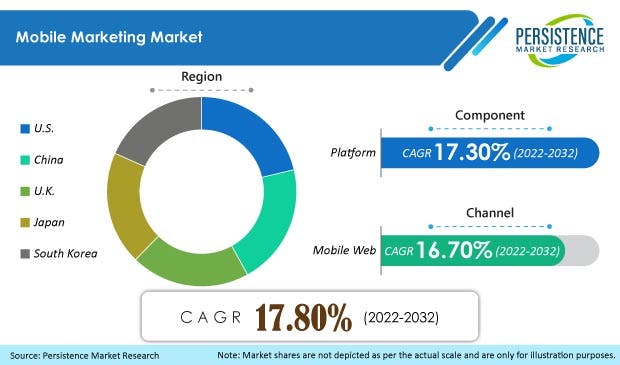Marketing Technology
Keynotes:
- The mobile market is a huge opportunity for B2B companies to reach their customers in new ways.
- The global mobile marketing market is expected to reach $91 billion by 2032.
- The future of the market will be shaped by advances in technology and how marketers use them.
According to Persistence Market Research (PMR), the global mobile marketing market is expected to grow from $17.6 billion in 2022 to $91 billion by 2032. As a 3rd-party research organization that operates through an exclusive amalgamation of market research and data analytics, the company predicts a robust CAGR of 17.8% over the next decade.
PMR attributed the high growth of the mobile marketing market to multiple factors. The report, Market Study on Mobile Marketing, notes that growth will be driven by several factors, including:
- The growth of social media marketing, website monitoring, and search engine optimization
- The adoption of Augmented Reality (AR) in the retail sector to analyze consumer behavior
- The increasing adoption of Artificial Intelligence (AI) and predictive search across all channels
- The rising number of mobile customers who prefer online shopping while going through omnichannel to make themselves aware of the product and services
- The high penetration of smartphones, better network bandwidths, and easy shopping
The report states that aside from the above-mentioned driving factors, Covid –19 has also been a huge driving factor for this growth. Over the course of the pandemic, major market players in the industry have successfully turned challenges into opportunities, increasing their market share. Also, as organizations embrace work-from-home policies, the demand for cloud services has increased, requiring businesses to focus on consumer experience surveys and insights to provide the best behavior and services. As a result, mobile marketing has grown in demand and the impact of a pandemic has leveled out on sales of the mobile marketing industry.
The report further highlights that the growing adoption of smartphones and tablets has allowed marketers to use digital channels for reaching out to customers. More users are opting for ads on their mobile devices, and mobile devices are being increasingly used by marketers as an effective medium for content delivery, promotions, and advertising campaigns. This has led companies to invest more heavily in this space which has resulted in increased competition among players operating within this industry.
In addition, the report notes that North America is likely to be the largest revenue contributor to the worldwide mobile marketing market during the forecast period, because of the increasing adoption of mobile marketing platforms and services among businesses in this region. However, countries like China, the United Kingdom, Japan, and South Korea, are expected to witness a significant growth rate during the forecast period due to the increasing adoption of mobile marketing strategies by companies in Europe and the Asia-Pacific regions.

Mobile Marketing Market
Limitations to the Growth of the Mobile Marketing Market
With the increasing popularity of social media platforms such as Facebook, Instagram, TikTok, Twitter, and LinkedIn; marketers have started using them for delivering their messages directly to consumers on a large scale basis. Moreover, incorporating artificial intelligence and analytics into these social media platforms will positively impact the market share growth of mobile marketing. However, because the entire data structure formats are both structured and unstructured, the increased challenges of integrating electronic data transfer and data sync will likely constrain the growth of the mobile marketing market.
As highlighted in the mobile marketing market study by Persistence Market Research, one of the factors that will hinder the growth of this market is, little or zero knowledge of the target customer. Many marketers are skeptical about if their target customer is mobile, so they avoid using the framework. Other limitations to the growth of this market include irresponsive website and content, the increased adoption of ad-blocking software by smartphone users, stringent privacy and government regulations governing mobile advertising, the rise in the cost of customer acquisition, and lack of standardization in mobile marketing.
The Future of Mobile Marketing
In the years since its introduction, mobile marketing has become a staple of the digital marketing world. As consumers continue to spend more time on their smartphones and tablets, businesses are looking towards this channel to reach new customers and engage existing ones. However, with competition increasing every day, marketers need to know where they stand in terms of mobile readiness.
In the B2B space, mobile marketing will continue to be driven by the growth of smartphones and tablets, as well as connected devices such as wearables and smart TVs. The rise of 5G networks will also provide new opportunities for B2B marketers to reach their target markets on the go with rich media content, including video streaming.
Although mobile marketing is still in its infancy, it has experienced massive growth over the past few years. This report demonstrates that the next decade is going to bring even more change, and mobile marketing will continue to become more and more important for B2B companies. Digital advertising spending will continue to be dominated by mobile advertising and it will be the most popular channel for advertising.

